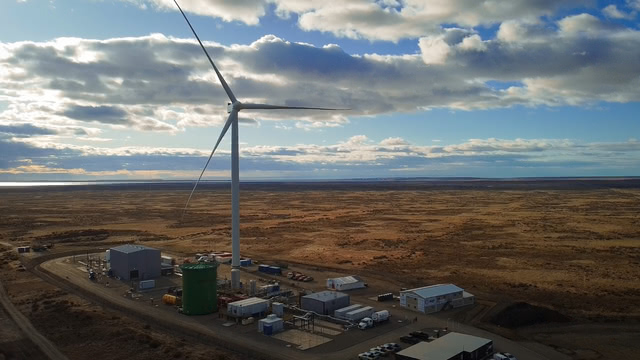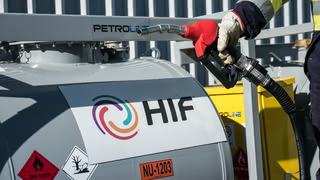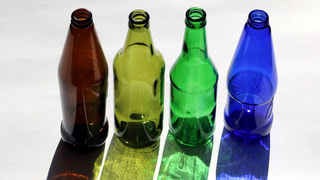Hype and E-Fuels: The Haru Oni pilot plant
Making fuel just from wind, water, and air – that's the promise of the Haru Oni project in Chile. But claims by the companies operating the plant contain a lot of hype.

It's a bold promise: With renewable electricity from wind power, green hydrogen produced by splitting water, and carbon dioxide taken from the air, one could make fuels like gasoline that would have the same properties as traditional fuels.
The Haru Oni project in Chile, operated by the company HIF, is promising to do just that, and it has some notable supporters: Partners of the project include Siemens Energy and the car maker Porsche. Haru Oni has received more media attention than any other e-fuels project.
The idea of e-fuels is to use renewable electricity to synthesize chemicals that can be used as fuels. Ideally, burning them causes only as much carbon dioxide as what has been used in their production.
E-fuels are controversial, as producing them is very inefficient. Therefore, the prevailing view is that if e-fuels are used, then that will primarily happen in sectors with few alternatives - like long-distance aviation and shipping. However, a vocal group of people, particularly in Germany, believes that e-fuels will play a significant role as a future fuel for cars.
The Haru Oni demonstration plant is located in the Magallanes Region, the southmost part of Chile. It opened in December 2022. It received substantial financial support from the German government.
A single wind turbine currently powers the plant. The energy is used to run electrolyzers that split water into hydrogen and oxygen. The hydrogen is then used together with carbon dioxide to synthesize methanol.
The Direct Air Capture Plant is not there
Until recently, HIF and its project partners had communicated that the plant would use carbon dioxide directly from the air. Technology to filter carbon dioxide from the air exists and is known as direct air capture technology. However, it is currently only used in small pilot facilities.
But the direct air capture facility for the Haru Oni plant has yet to be built. A video by the YouTube channel Donut Media shows that carbon dioxide is currently delivered by trucks.
In March this year, HIF announced a collaboration with a company named Baker Hughes on direct air capture technology. Baker Hughes acquired a company called Mosaic Materials last year that is developing direct air capture technology.
When asked about this, HIF answered: "For the Haru Oni demonstration plant, the carbon dioxide comes from a biogenic source (fermentation process of a brewery). This is a temporary CO₂ source while we wait for the direct air capture technology to be ready."
After some media reports highlighted the lack of a direct air capture facility, HIF and its partners have removed corresponding claims from their websites. Until a few weeks ago, one could read this on the webpage of Siemens Energy: "Synthetic fuel is produced from water, wind energy, and CO₂ captured from the air." Now it says: "Synthetic fuel is produced from water, wind energy, and biogenic CO₂."
The Haro Oni project's website is no longer online, but it can still be accessed via the Internet Archive. This was the information HIF communicated when the plant opened last year. According to that, HIF claimed that the plant would use technology from Global Thermostat, another company developing direct air capture technology.
Haru Oni is primarily a Methanol Plant
According to that webpage, Haru Oni produces around 750,000 liters of methanol annually (about 600 tons).
While methanol can be used as a fuel in theory, it cannot be used to power conventional cars. Therefore, some of that methanol is fed into a methanol-to-gasoline process. Again, from the project's website: "The output of the demonstration plant will be 130,000 liters of synthetic gasoline." (For US readers: around 34,000 gallons.)
In other words: It is not a lot. It would not even be enough to power a single gas station. But another thing is notable: While Haru Oni is often referred to as an e-fuels plant and, particularly due to the partnership with Porsche, is often mentioned in the discussion about the future of cars, it is primarily a plant producing methanol. Only a tiny fraction of the methanol is turned into gasoline.
Haru Oni is a demonstration plant to showcase the technology, and HIF plans to expand production. Again, from the old webpage: "In two steps, capacity is planned to be increased to 55 million liters e-gasoline per year by 2025 and over 550 million liters per year by 2027."
To put this in perspective, while only a small demonstration plant is running right now, HIF had announced increasing production 400-fold in the next two years and 4,000-fold two years later. These are bold plans. However, this is unlikely to happen, as the construction of these much larger production facilities has not even started.
Plans are to build a larger production plant in the Cabo Negro industrial area. There already exists a fossil-fuel-based methanol plant by the company Methanex in Cabu Negro.
HIF announced in October last year that the company withdrew the environmental permit application for the wind park that was supposed to power the facility in Cabo Negro.
Asked about this, HIF comments: "We withdrew the environmental permit of Faro del Sur Wind park last year due to observations that were made to the project but different agencies, which is a normal part of the process. We are aiming to file the permit for Faro del Sur again in the upcoming months."
Thorsten Herdan, CEO of HIF in the EMEA region, confirmed in a conversation and via e-mail that construction has not started yet. According to Herdan, HIF plans to make a final investment decision by 2024. Asked whether Siemens Energy and Porsche will be partners in that larger project, Herdan writes that the project partners are not confirmed yet.
In our conversation, Herdan also told me that HIF has not yet decided what it will produce in this larger plant – whether it will be gasoline or methanol.
What do we make of all that? Haru Oni is a small demonstration plant producing methanol from green hydrogen and biogenic carbon dioxide. A small fraction of that methanol is turned into gasoline. The technology works, but it is small scale.
The companies behind it had made questionable claims around the use of direct air capture when it was not there and about ambitious scale-up plans that will certainly not happen in the timeframes communicated.
One thing seems noteworthy: Haru Oni is often quoted as a technology that could provide a future for combustion-engine cars. However, the actual Haru Oni plant produces more methanol than gasoline – and the same may be true for future plants that HIF is planning.
Green methanol could be used as a fuel, but likely not for cars. Methanol cars exist and have a certain market share in China, but it is a niche market. However, an industry looking into methanol as a fuel is the shipping sector.
Particularly in the European Union, the shipping industry is under pressure to reduce its greenhouse gas emissions. Ships emissions will soon be part of the EU's emission trading system (ETS), which means ship owners must buy emission certificates for the carbon dioxide they release.
Synthetic, green methanol, when made from biogenic carbon dioxide or with direct air capture, is considered a promising option as a future clean shipping fuel. Green methanol could also become a feedstock for a less polluting chemical industry.
Maybe the follow-up projects of Haru Oni will produce significant amounts of green fuels in the future. But possibly not for cars.
Author: Hanno Böck
Elsewhere
A research project sends carbon dioxide emissions from a biogas plant in Switzerland to a storage site in Iceland. I interviewed the scientist behind the project and covered it for Fathom World.
In another text for Fathom World, I looked at a report about managing emissions from ammonia-powered ships by the Mærsk Mc-Kinney Møller Center for Zero Carbon Shipping.
Brief
-
Green steel can be made with hydrogen, and experimental processes exist to make it with pure electricity. But is making steel directly with Ammonia also an alternative? Researchers of the Max-Planck-Institut für Eisenforschung (MPIE) have tested the process on a laboratory scale.
-
C1, a startup from Berlin developing green methanol technology, presented its first pilot reactor for its technology.
-
Many hope that cheap green hydrogen will become an essential building block of decarbonization technologies. But CRU, a market analysis firm from the UK, argues that such hopes may be unrealistic and expects that hydrogen will still be expensive in 2050.
-
Carbon dioxide removal (CDR) technologies may be able to remove the greenhouse gas from the atmosphere in the future. But there are concerns about how to best develop and use the technology. Climate scientist David Ho argues in Nature that drastic emission cuts must come before any significant deployment of such technologies. Carbon180, a US NGO focussing on CDR technology, argues that using captured CO₂ for enhanced oil recovery should be excluded from direct air capture projects.
-
Readers of this newsletter will know about the controversies around the future of gas grids. In Germany, the think tank Agora Energiewende expects that 90 percent of the gas distribution networks will become obsolete and recommends planning the decommission of the grid. Julian Wettengel summarizes Agora's announcement in English for Clean Energy Wire.
-
The New York Times looked at Bitcoin mining facilities and found that - unlike what its proponents claim - most of them are powered by fossil fuel energy.
-
The Volts podcast is always worth listening to, but I would like to recommend a recent episode about Biofuels especially.
-
Worried about mining and metals required for the energy transition? While it is true that clean energy requires more metals, the Distilled newsletter points out that the mining required is tiny compared to the mining of fossil fuels.
-
A comment by Bill McKibben worth reading: Yes in Our Backyards.



